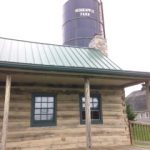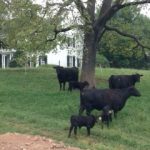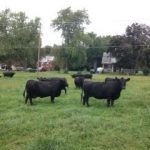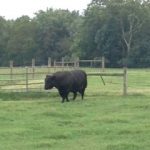I enjoyed the opportunity to tour Hedgeapple Farm (run by the Jorgensen Family Foundation, Inc) this week. The farm sits on about 310 acres near Frederick Maryland and raises Black Angus cattle.The tour began with a brief overview by Executive Director Dr. Scott Barao who shared the history of the farm and the definition of grass fed. While consumers may relate to the term “Grass fed”, the detail is actually in how the cow is “finished”. “Grass-finished” cattle are only offered pasture grass and hay through their entire life. This is the case with the Angus at Hedgeapple Farm.
After our short chat in the country store, we jumped on a hay wagon and toured the property. Our first stop gave us a view of the fall calves. Calves are born in the fall and spring generally, and will nurse and graze for about 6-8 months at which point they are weaned from their mothers and moved to another pasture.
We then stopped by a field where cows were almost ready to be shipped for processing. It takes about 2-3 years to bring beef from farm to fork, and there’s a lot of care and attention that occurs during that time.
Bulls are kept in their own areas, of course.
Finally, we toured the barn, where cattle are brought for health inspection or any medical intervention. While there’s no reason to give antibiotics here unless there is an infection or illness, they will of course treat the animals if they get sick.
The day closed with a panel discussion and an opportunity for the dietitians in the audience to ask unlimited questions. I’ll have a follow-up blog with more news about that Q&A later this week.
Disclosure: I was invited by the Northeast Beef Promotion board to tour Hedgeapple Cattle Farm, but I was not paid to write this post.








